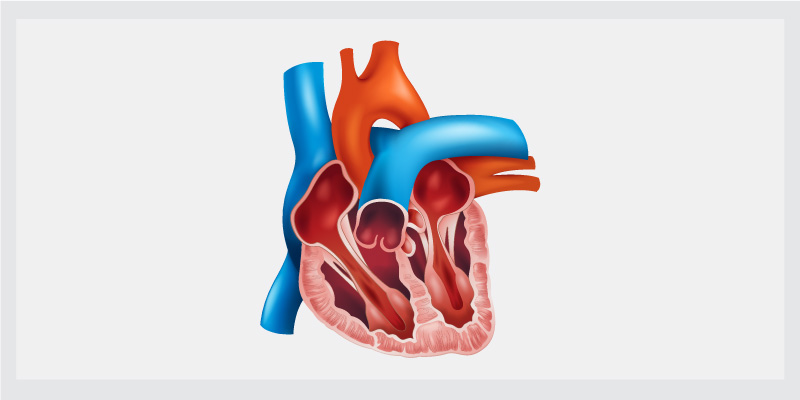Aortic Valve Stenosis happens by the narrowing of the aortic valve present in the heart. The aortic valve’s contraction restricts the opening of the valve completely, which blocks or reduces the flow of blood from the heart in the artery to the body, known as the aorta, and after that to the other parts of the body.
If the flow of blood by the aortic valve is blocked or reduced, the heart requires more blood to be pumped to the body. This additional work restricts the quantity of blood the heart pumps, and this can result in the weakening of the heart muscle. Aortic Valve Stenosis needs professional help as soon as the symptoms are detected, as it can cause severe heart issues.
Some Common Facts about Aortic Valve Regurgitation
- Aortic Valve Stenosis is the contraction of the aortic valve, blocking the transfer of blood from the heart to different parts of the body.
- It is also known as Aortic Stenosis.
- Aortic Valve Stenosis is commonly abbreviated as AS.
- Aortic Valve Stenosis is the most common and severe valve disease.
- It is the third most common cardiovascular disorder after coronary artery disorder and hypertension.
- A few people have Aortic Valve Stenosis caused by a congenital heart defect, known as the bicuspid aortic valve.
- This condition generally occurs while aging as scarring or calcium weakens the valve and reduces the amount of blood flow through the valve.
- It is more common in men than in women.
- According to the study conducted by NCIB, The predominance of Aortic Valve Stenosis rises from 2% in adults above the age of 65 years to 4% in adults above 85 years of age.
Causes of Aortic Valve Regurgitation

The heart possesses four valves that manage blood flow in the right direction. These heart valves incorporate the tricuspid valve, mitral valve, aortic valve, and pulmonary valve. Every valve holds flaps that open and closes while every heartbeat. At times, the heart valves do not function accurately, obstructing the blood flow by the heart, and possibly reducing the capacity of pumping blood to the body.
In this case, the aortic valve connecting the ventricle, and the artery that carries blood from the heart to different parts of the body, termed as the aorta, becomes narrowed.
The narrowing of the aortic valve leads the ventricle to work more to pump an adequate quantity of blood in the aorta and also to the rest parts of the body. This condition can result in the enlargement and thickening of the left ventricle. The extra work executed by the heart can impair the ventricle and can cause heart failure or other problems.
Many conditions can cause Aortic Valve Stenosis, inclusive of:
Congenital Heart Deficiency
The aortic valve comprises three tightly fit, triangular flaps of tissue known as cusps. Some people have an inborn disorder in which the aortic valve holds only two cusps rather than three. In rare cases, people are born with one cusp, known as unicuspid, or with four cusps, known as quadricuspid.
This disorder may not generate any difficulties until adulthood. By that time, the narrowing or leakage of the valve may start.
Calcium Buildup at the Valve
Along with time, heart valves can collect calcium deposits, known as aortic valve calcification. As blood flows from the aortic valve, calcium deposits can develop on the cusps of valves. The calcium deposits may not create any issues.
But, in certain people, especially with a congenitally irregular aortic valve, like a bicuspid aortic valve, the deposits of calcium cause tightening of the cusps. This can result in the narrowing of the aortic valve.
Aortic Valve Stenosis is associated with an increase in age and also with the accumulation of calcium at the aortic valve is common in elderly people. It normally does not cause any symptoms until the ’80s.
Rheumatic Fever
The strep throat disease or rheumatic fever can arise within the scar tissue building on the aortic valve. This scar tissue can cause the narrowing of the aortic valve and can begin Aortic Valve Stenosis. This tissue can form a stern surface at which the deposits of calcium can accumulate, adding upon to Aortic Valve Stenosis. Rheumatic fever is very rare and this may affect or harm the heart valve.
Risk Factors of Aortic Valve Regurgitation
The risk factors concerning Aortic Stenosis include:
- Chronic kidney disease
- History of diseases that can harm the heart
- Older age
- History of radiation therapy
- Possessing cardiovascular risk factors, like high blood pressure, diabetes, and high cholesterol
- Congenital heart disease like bicuspid aortic valve
Symptoms of Aortic Valve Regurgitation

Aortic Valve Stenosis varies from mild to severe. The symptoms usually develop in case of a severe narrowing of the valve. Most of the people with aortic stenosis may not experience the signs and symptoms for several years. Symptoms of Aortic Valve Stenosis may involve:
- Heart murmur
- Angina
- Tightness in the chest
- Shortness of breath
- Feeling dizzy
- Fatigue
- Weight loss
- Heart palpitations
Signs and symptoms of Aortic Valve Stenosis in infants and children include:
- Poor feeding
- Not gaining enough weight
- Becoming easily tired with exertion
- Severe breathing issues that develop within days or weeks of birth
The weakening of the heart due to Aortic Stenosis may lead to heart failure. The signs and symptoms of heart failure include:
- Shortness of breath
- Fatigue
- Swollen ankles and feet
Diagnosis of Aortic Valve Regurgitation

To diagnosis Aortic Valve Stenosis, the tests may include:
- Echocardiogram
- Electrocardiogram (ECG)
- Chest X-ray
- Exercise tests or stress tests
- Cardiac computerized tomography (CT) scan
- Cardiac MRI
- Cardiac catheterization
Conclusion
The aorta carries blood from the heart to different parts of the body. The blood flows from the heart and in the aorta by the aortic valve. The aortic valve does not open and closes completely, in the Aortic Valve Stenosis. Consult a doctor, as soon as the signs and symptoms of Aortic Valve Stenosis are visible.




